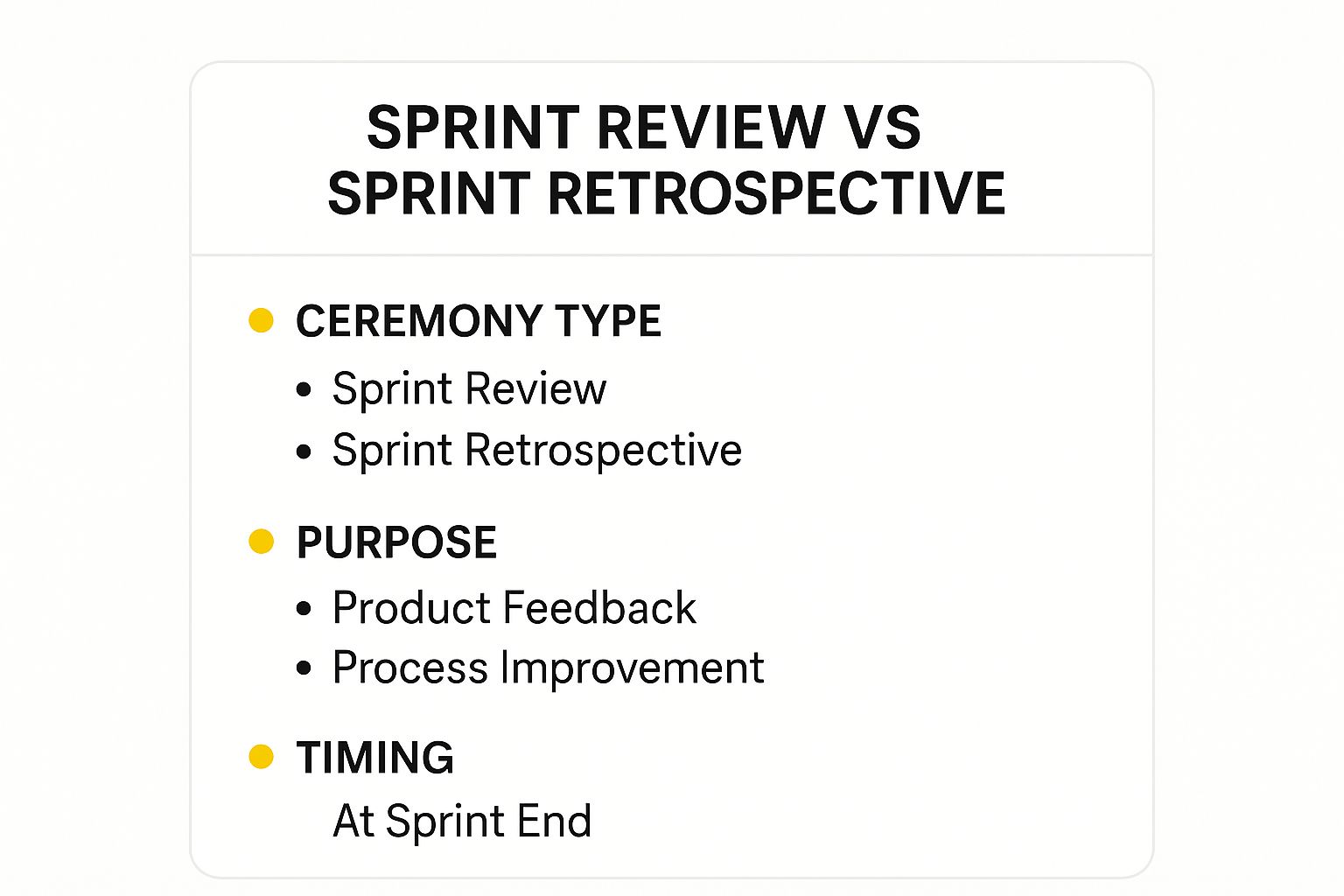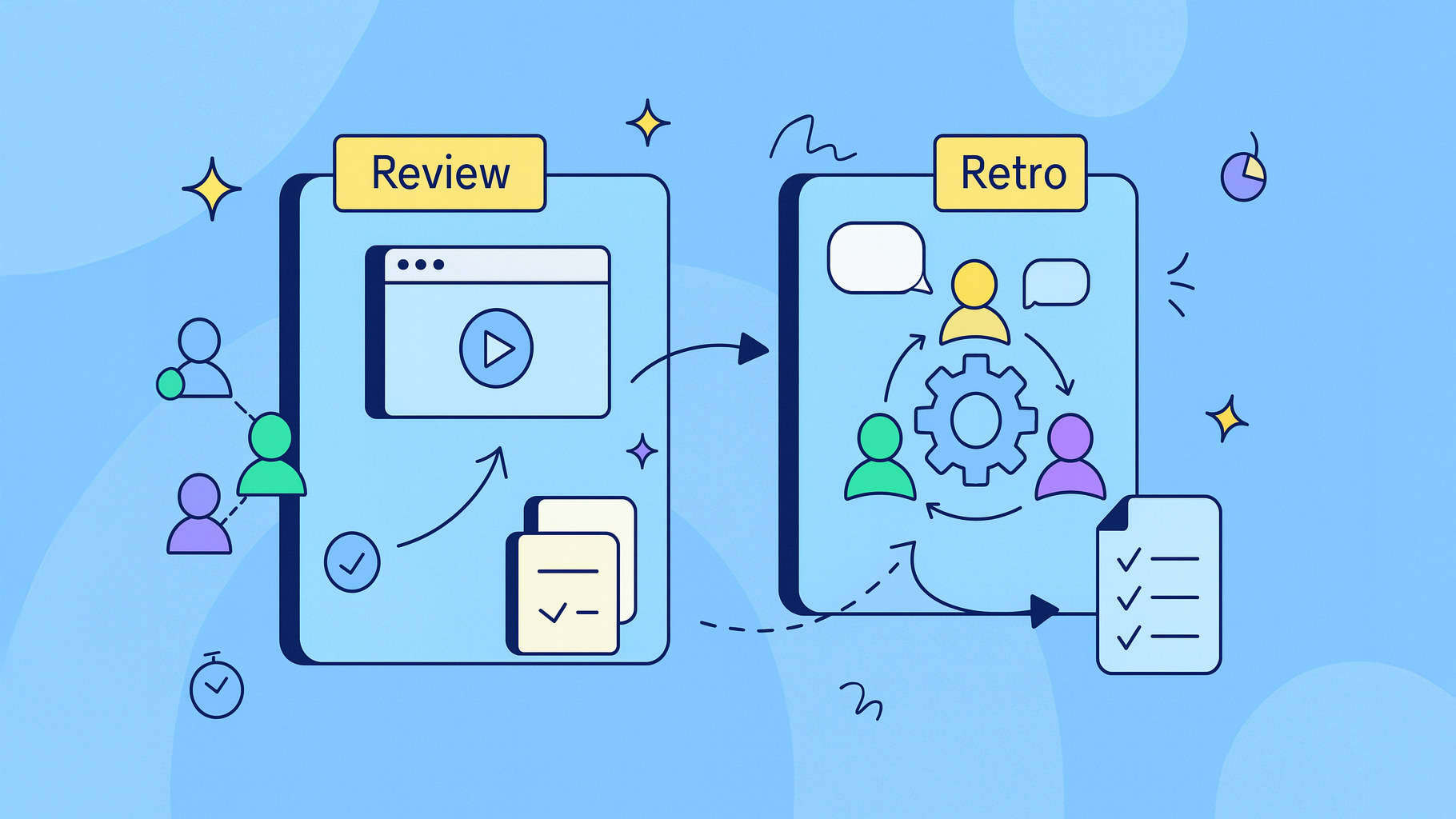It’s easy to get these two meetings mixed up, but the core difference between a sprint review and a retrospective is pretty straightforward.The sprint review focuses on the product—what the team built—and you bring in stakeholders for their feedback. On the other hand, the sprint retrospective is all about the process—how the team worked together—and it’s strictly an internal affair for the Scrum team.
Clarifying the Core Difference
While both ceremonies cap off the end of a sprint, they have completely different jobs to do within the Scrum framework. If you blur the lines between them, you’ll end up with confusing feedback loops and miss huge opportunities for the team to actually get better. Just remember: the sprint review looks outward, while the retrospective looks inward.
Think of it this way: the sprint review is designed to get the Scrum team and its stakeholders in the same room to inspect the product increment that was just delivered. The retrospective, however, is a closed-door session for the Scrum team to reflect on their own teamwork and processes, figuring out what to tweak for the next sprint.
At-a-Glance Sprint Review vs Retrospective
To cut through the noise, here’s a simple side-by-side comparison that breaks down the fundamental differences between these two critical Scrum events.
| Attribute | Sprint Review | Sprint Retrospective |
|---|---|---|
| Primary Focus | The product increment and its value | The process, team dynamics, and collaboration |
| Core Question | “What did we build, and is it right?” | “How did we work, and how can we improve?” |
| Participants | Scrum Team & External Stakeholders | Scrum Team only (Scrum Master, Product Owner, Developers) |
| Key Outcome | Updated Product Backlog based on feedback | Actionable improvement items for the next sprint |
This quick table really hammers home the separation. One is about inspecting the product for external validation, and the other is about improving the team’s internal engine.

As the graphic shows, even though both meetings happen at the end of a sprint, their purpose dictates everything—from who gets an invite to what you actually accomplish. Nailing the flow and agenda for each is essential. Our guide on crafting a perfect sprint review meeting agenda can help make sure your product-focused discussions hit the mark every time.
Mastering the Sprint Review for Product Success
The sprint review is much more than a simple demo. Think of it as a strategic, collaborative session where you inspect the latest product increment and adapt the product backlog accordingly. This meeting is your single most important feedback loop, ensuring the development team is building the right thing at the right time.
Its success truly hinges on two things: a transparent demonstration and a candid discussion with key stakeholders. This is where we examine the “what” of the sprint. The Scrum team presents the work they’ve completed, but the goal isn’t just to show off cool new features. The real prize is gathering valuable insights from stakeholders, who bring crucial market and user perspectives the team might otherwise miss.

Who Attends and Why They Matter
Unlike the internally focused retrospective, the sprint review’s guest list is broader and just as important as its agenda. Of course, the entire Scrum Team—Product Owner, Scrum Master, and Developers—must be there. But the real power of the review comes from inviting the right stakeholders.
These participants should ideally include:
- End-users or customer representatives who provide direct feedback on usability and value.
- Business executives or sponsors who make sure the product aligns with company strategy.
- Marketing and sales team members who can offer insights into market positioning and what customers are asking for.
Their active participation is essential. They are not a passive audience; they are collaborators whose input directly shapes the product’s future. This interaction validates the work done and helps forecast what comes next.
The sprint review is where theory meets reality. It’s the moment the team and stakeholders collectively decide if the product is on track to deliver real-world value, making it a critical pivot point for the product backlog.
Running an Effective Sprint Review
A well-structured review keeps the conversation productive and focused on outcomes. Just running through features isn’t enough; the meeting has to generate a clear path forward. Without a solid structure, it can easily devolve into a feature showcase with zero actionable takeaways.
Here’s a practical agenda to guide your session:
- Restate the Sprint Goal: Kick things off by reminding everyone what the team set out to achieve. This gives crucial context for the work about to be demonstrated.
- Demonstrate the Increment: The development team shows the working software. This needs to be a hands-on demonstration, not a slide deck, focusing only on what is truly “Done.”
- Facilitate Open Discussion: The Product Owner then leads a conversation about what was accomplished and what challenges came up. Stakeholders jump in with questions and feedback.
- Review Key Metrics: Discuss any relevant metrics, like progress toward product goals or market changes that might impact future plans.
- Adapt the Product Backlog: Based on all the feedback, the Product Owner and stakeholders collaboratively adjust the product backlog. This is the meeting’s most crucial output.
Following this flow transforms the sprint review from a status report into a powerful planning tool. For a deeper dive, learn about mastering sprint reviews with NASA Agile Meetings for Teams to ensure your discussions lead to concrete results.
Driving Team Growth with the Sprint Retrospective
While the sprint review looks outward at the product, the retrospective turns the focus inward, examining the team’s process, collaboration, and overall health. This ceremony is the real engine of continuous improvement. It carves out a dedicated, safe space for an honest, blame-free conversation about how the team works together.
This is where you uncover the hidden frictions and start dismantling those frustrating systemic roadblocks.
The main goal is to inspect how the last sprint went from the perspective of individuals, interactions, processes, and tools. Success absolutely depends on creating an environment of psychological safety, where everyone feels comfortable talking about failures without fear of judgment. This is the critical difference when you compare the sprint review vs retrospective; one is a presentation of work, the other is more like a candid therapy session for your workflow.

Facilitating Genuine Reflection
An effective retrospective goes way beyond just asking “What should we start, stop, and continue?” That format gets old fast, and the insights dry up. A skilled facilitator, usually the Scrum Master, knows how to mix up the formats to spark fresh perspectives and get to the heart of an issue.
The key is to guide the conversation from simple observations to actionable changes.
Here are a few powerful alternatives to try:
- The 4 Ls (Liked, Learned, Lacked, Longed For): This structure promotes a really balanced discussion, making sure you cover the positives, new knowledge, obstacles, and what the team hopes for in the future.
- Mad, Sad, Glad: This technique taps into the emotional journey of the sprint. It’s fantastic for uncovering underlying issues with morale or team dynamics that might not surface otherwise.
- Sailboat Retrospective: Using the metaphor of a sailboat, the team identifies anchors (what’s holding them back), the wind (what’s pushing them forward), and the island (their shared goals).
A successful retrospective doesn’t just identify problems; it empowers the team to own the solutions. The output should always be a small, concrete improvement that the team can implement immediately in the next sprint.
From Discussion to Actionable Improvement
The most important outcome of a retrospective isn’t the discussion itself—it’s the commitment to take real action. Without it, the meeting devolves into a complaint session with no resolution, which quickly leads to team disengagement. The goal should be to collaboratively identify one or two high-impact improvements to focus on.
These action items must be specific and measurable. For instance, instead of a vague goal like “improve communication,” a much better action item is: “We will dedicate the first five minutes of the daily stand-up to unblocking each other before discussing individual progress.”
This specific commitment then gets added directly to the next sprint backlog. This ensures it’s treated as real work, not just a good idea that gets forgotten.
This cycle of reflection and adaptation is what builds a resilient, high-performing team. For a deeper dive into facilitation techniques and best practices, check out our guide on mastering the retrospective in your sprint. By consistently refining their own processes, teams can resolve conflicts, eliminate waste, and ultimately deliver more value with a lot less friction.
Comparing the Focus, People, and Outcomes
Even though the sprint review and retrospective both happen at the very end of a sprint, they are completely different beasts. Their DNA is fundamentally distinct, and it all boils down to three core elements: their focus (what are we looking at?), the people involved (who is doing the looking?), and their outcomes (what happens next?). Getting this right is absolutely crucial for any team trying to get real value out of their Agile process.
Think of the sprint review as an outward-facing event. Its entire purpose is to inspect the product increment—that tangible, usable chunk of work the team just finished. The big question here is, “Did we build the right thing?” It’s a hands-on, collaborative conversation about the product’s value and whether it truly meets the needs of stakeholders and the market.
The sprint retrospective, on the other hand, is an inward-facing, reflective session. It’s all about the team and its processes. The central question becomes, “How can we work better together?” This is dedicated time to really dig into how the team collaborates, the tools they use, communication styles, and team dynamics to find solid opportunities for improvement.

Participants: The External Audience vs. The Internal Team
The guest list for each meeting really tells the story. A sprint review is basically an open house. You’ll want to invite key stakeholders from outside the immediate Scrum team—people like customers, executives, marketing leads, or support staff. Their presence is vital because their feedback directly shapes where the product goes next. The review thrives on this external validation and diverse perspective.
But the sprint retrospective? That’s a closed-door meeting, strictly for the Scrum Team: the Developers, the Product Owner, and the Scrum Master. This isn’t about being secretive; it’s about creating a zone of psychological safety where team members can be brutally honest about challenges, failures, and even interpersonal friction without worrying about judgment from outsiders.
The starkest contrast between a sprint review vs retrospective lies in the participants. One is a transparent showcase for stakeholders to steer the product, while the other is a private workshop for the team to tune its engine.
Tangible Outcomes: Shaping the Backlog vs. Improving the Process
Naturally, the outputs from these meetings are just as distinct as the attendees. A successful sprint review has a direct, tangible impact on the product itself. The primary outcome is a revised Product Backlog. After seeing the demo and giving feedback, the Product Owner might re-prioritize items, add new user stories, or even kill features that are no longer relevant.
In contrast, a great retrospective produces one or two actionable improvement items that the team commits to implementing in the very next sprint. These aren’t vague ideas; they’re concrete process changes like, “We will pair-program on all complex bug fixes,” or “We’ll update our definition of ‘Done’ to include automated testing.” These items are often added directly to the Sprint Backlog, treating them as real, accountable work.
This difference in timing and attendance has a measurable impact. Sprint reviews can last from one to four hours, depending on stakeholder engagement, while retrospectives are typically shorter, averaging 30 to 90 minutes with only the core team. Furthermore, a 2023 Agile report showed that teams conducting retrospectives every sprint boost their velocity by an average of 15% over those who do them less often. You can discover more insights about Agile meeting effectiveness on Indeed.com.
Why Merging These Meetings Is a Costly Mistake
In the constant push for efficiency, I’ve seen many teams get tempted to combine the sprint review and retrospective into one meeting. It looks like a smart way to save an hour on the calendar, but this is a classic anti-pattern that sabotages both events and cuts the legs out from under Agile principles.
Let’s be clear: blurring these lines doesn’t create efficiency. It just creates confusion and grinds progress to a halt.
The core problem is a fundamental conflict between their goals and their audiences. The sprint review is an outward-facing showcase for stakeholders. Its job is to demonstrate what was built, gather feedback on the product, and get everyone aligned on the path forward. This requires a certain level of polish and presentation.
The retrospective, on the other hand, is a private, inward-facing session strictly for the Scrum team. It’s where the team needs to feel safe enough to get vulnerable—to talk about failures, frustrations, and interpersonal friction so they can improve their process. These two environments are polar opposites and simply can’t coexist.
The Breakdown of Psychological Safety
The moment stakeholders walk into what should be a retrospective, psychological safety plummets. Team members are suddenly far less likely to admit that a process is broken, that they struggled with a task, or that a communication breakdown caused a delay.
The fear of appearing incompetent in front of leadership or clients is a powerful silencer. As a result, the conversation stays at a shallow, surface level. Instead of digging into the root causes of impediments, the discussion becomes a performative, sanitized version of reality. Genuine process improvement is dead on arrival when the real problems are never brought to light.
Combining these meetings forces a choice between product transparency with stakeholders and process transparency within the team. You cannot have both at the same time, in the same room. One will always compromise the other.
Disengaged Teams and Stagnant Processes
This approach quickly leads to a disengaged team. If retrospectives consistently fail to produce meaningful change because no one is really speaking up, team members will start seeing the meeting as a complete waste of time. They’ll stop contributing, and the cycle of repeating the same mistakes continues, sprint after sprint.
This isn’t just an anecdotal problem. Globally, 15% of surveyed teams mistakenly merge these meetings or skip retrospectives altogether, which correlates with a 10-12% drop in their overall Agile maturity scores. These numbers, highlighted in an insightful Geekbot article, show just how vital it is to respect the distinct nature of the sprint review vs retrospective.
Ultimately, merging these meetings saves a tiny bit of time upfront at the immense cost of long-term improvement. It prevents the team from inspecting and adapting its own way of working, which is the very engine of agility. For any organization looking to scale its improvement efforts effectively, separating these ceremonies is non-negotiable. For a deeper look at scaling improvement, you might want to explore concepts like the retrospective of retrospectives.
Common Questions About Sprint Reviews and Retrospectives
Even when you know the difference between a sprint review and a retrospective, practical questions always pop up when it’s time to put theory into practice. Figuring out the finer points of facilitation, who needs to be there, and how to follow through is what separates a valuable ceremony from just another meeting.
Let’s tackle some of the most common challenges teams run into. By addressing these questions head-on, you can run both meetings with more confidence and make sure they actually lead to something meaningful.
Who Should Facilitate Each Meeting?
One of the first points of confusion is often who should lead each session. While roles can be flexible depending on your team’s maturity, there are some best practices that usually deliver better results.
- Sprint Review: The Product Owner is almost always the best person to facilitate the sprint review. They are the keeper of the product vision and are in the perfect position to steer the conversation between the development team and stakeholders. This ensures the feedback you get is directly relevant to the product backlog.
- Sprint Retrospective: The Scrum Master is the natural choice to facilitate the retrospective. Their job is to be a neutral guardian of the process. They create a safe space where the team can have frank, honest discussions without anyone worrying about judgment.
What if We Had a “Perfect” Sprint?
It’s a fantastic problem to have, but what do you do in a retrospective when everything just… worked? A successful sprint is the perfect time to figure out why it was so successful. Don’t just skip the retro; use it to pinpoint the positive patterns you want to repeat.
A retrospective after a great sprint isn’t about inventing problems. It’s about reverse-engineering your success so you can do it again. Ask questions like, “What specific things did we do that led to this?” or “How can we make sure these conditions are in place for the next sprint?”
This approach transforms a lucky break into a repeatable strategy. It helps the team truly understand its strengths and build a playbook for consistent high performance.
Can the Product Owner Skip the Retrospective?
In a word: no. The Product Owner is a crucial part of the Scrum Team, and their participation is non-negotiable. They are just as much a part of the team’s process as anyone else, and their perspective is essential for improving how development and product vision work together.
Their presence makes sure that any process improvements take the entire value stream into account, from the first idea to the final delivery. Leaving them out creates a silo and guarantees you’ll miss opportunities to refine how the entire unit collaborates. A great team inspects and adapts together.
If you’re looking for ways to keep your retrospectives fresh and engaging, exploring different formats is a great idea. You can get some inspiration from the best sprint retrospective template tools, which can help introduce new perspectives and more structured conversations.
At resolution, we build tools that foster clarity and collaboration in every meeting. NASA – Not Another Standup App is designed to help your team run structured, efficient, and engaging agile ceremonies right within Jira. Learn how NASA can elevate your sprint reviews and retrospectives.
